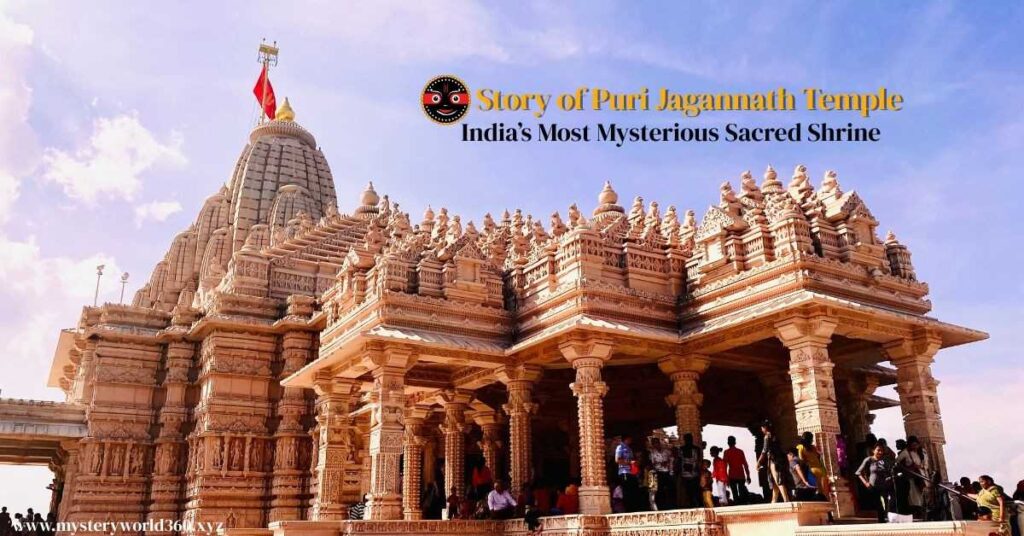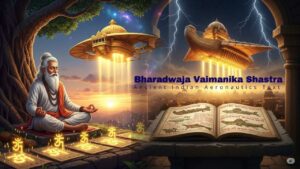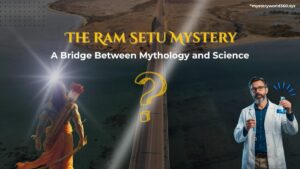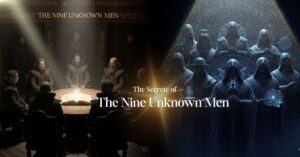The Mysterious Story of Puri Jagannath Temple: Secrets, Legends, and Divine Wonders
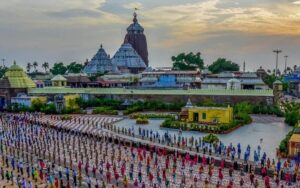
India is home to countless ancient temples, each with its own tale that blends history, divinity, and mystery. But among all of them, Puri Jagannath Temple, located in the coastal town of Puri in Odisha, stands out not just for its spiritual importance but for the jaw-dropping secrets and legends it hides within its sacred walls.
This article gives you the first deep dive (about 10% of the complete tale) into the story of Puri Jagannath Temple, where divine forces, ancient engineering, and unexplained wonders come together to create one of India’s most enigmatic holy sites.
A Temple Built by the Gods? | Story of Puri JagannathTemple
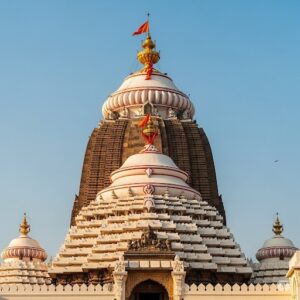
Legend has it that the Jagannath Temple was not built by human hands alone. According to the Skanda Purana, Lord Vishnu commanded King Indradyumna to build a shrine where the divine form of Vishnu would manifest as Jagannath. Guided by a divine dream, the king set out to find this place and eventually reached the seashore of Puri. A divine carpenter (believed to be Lord Vishwakarma, the architect of the gods) appeared and offered to carve the deities of Jagannath, Balabhadra, and Subhadra out of sacred neem wood. But there was a condition: no one should disturb him while he worked, and he would complete the work in 21 days.
Driven by excitement, the king waited. But after 14 days, when no sound came from inside the chamber, curiosity got the better of him. He opened the door—and found unfinished idols without hands or legs. The carpenter vanished.
That’s why even today, the idols of Jagannath, Balabhadra, and Subhadra are incomplete, yet worshipped with the highest reverence.
The Living Deities That Die and Reborn Every 12 Years
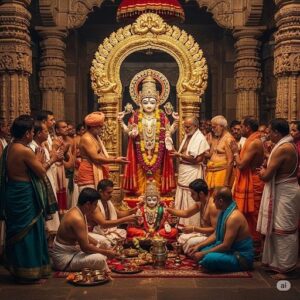
Another major mystery surrounding the Puri Jagannath Temple is the unique ritual called Navakalevara, which happens every 12 to 19 years (depending on the lunar calendar). During this time, the souls of the deities are believed to be transferred from old wooden idols to newly carved ones.
This isn’t just a symbolic ritual — the transfer is done in complete darkness, in total secrecy, by a select group of priests who are blindfolded. They perform the ceremony with their hands wrapped in cloth, so they never actually see or touch the mysterious “Brahma Padartha” – a mysterious life force believed to be eternal.
To this day, no one knows what exactly this “Brahma Padartha” is. It’s said to be so powerful that anyone who sees it dies instantly. Even the priests refuse to talk about what happens during the ritual.
The Flag That Defies the Wind

Physics says wind moves in one direction, right? Not in Puri. Here, the flag atop the Jagannath Temple always flutters in the opposite direction of the wind.
Whether it’s a storm, breeze, or no wind at all — the flag waves like it has a mind of its own. Scientists have visited the site and tried to explain it using aerodynamics, but nothing has been proven. Locals believe it’s a sign of divine energy, a symbol that defies natural law.
Not just that—every day, a priest climbs the 215-foot temple tower without safety gear, braving high winds just to change the flag. If a single day goes by without the flag being changed, it’s considered a bad omen for the entire region.
And guess what?
No Shadow, No Logic
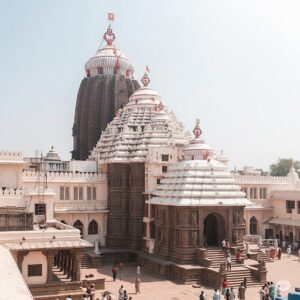
Here’s another bizarre feature: The main dome of the Jagannath Temple doesn’t cast a shadow—at least, not on the ground around it. No matter what time of day it is, or how bright the sun is shining, the shadow of the dome disappears into thin air.
Architects and engineers have tried to explain this phenomenon. Some say it’s the angle of construction, others suggest a play of light and illusion. But the truth is, there’s no scientific consensus on how it works.
It’s just another strange fact that adds to the mystical vibe of the temple.
The Sea’s Silence: Sound vs. Divinity
But not in Puri. Walk a few feet outside, and the sound returns like magic. Step back in—and it vanishes again.
Some say this was done intentionally by ancient architects, using acoustic tricks we still don’t understand. Others believe it’s divine design, a spiritual hush that sets the mood for devotion.
Jagannath’s Food Mystery
Here’s something wild: The Mahaprasad (sacred food) offered at the temple is cooked in clay pots stacked one over the other—up to seven levels high. Now, logically, the pot on top should cook last, right?
But in Puri Jagannath Temple, the pot on the top cooks first, and the bottom one cooks last. No one can explain how the heat works here.
Also, no matter how many people visit the temple in a day—not a single grain of food goes to waste or falls short. It’s said that Lord Jagannath himself decides how much food is needed, and somehow, the math works every single time.
The Untold Story of Puri Jagannath Temple
In the heart of Odisha, the story of Puri Jagannath Temple continues to unfold like a never-ending epic. After covering the divine origins and mysterious phenomena of this sacred site, we now dive deeper into the spiritual, historical, and architectural marvels that make the story of Puri Jagannath Temple an unforgettable journey through time, legend, and the supernatural.
This part takes you further into the sacred rituals, hidden chambers, powerful deities, and strange energies that still baffle even the sharpest minds of science and archaeology.
The Secret Rituals: What Happens Behind Closed Doors?
One of the most cryptic parts of the story of Puri Jagannath Temple is its secret rituals. These are not your everyday pujas. They are ancient rites performed by a special group of temple servitors known as the Daitapatis, believed to be descendants of the original tribal worshippers of Lord Jagannath.
These priests perform rituals that are not open to the public and are strictly guarded by tradition. During Anavasara, a 15-day period when the deities are said to fall ill after the Snana Yatra (a ceremonial bath), the temple gates are closed, and not even the highest-ranked devotees are allowed inside.
During this time, no one is allowed to see the deities, and they are “treated” with herbal medicines. This isn’t symbolic—many devotees firmly believe that the gods actually fall ill and recover just like humans.
The Rath Yatra: Chariots of the Gods
When it comes to the story of Puri Jagannath Temple, no tale is complete without mentioning the Rath Yatra—the grand chariot festival that draws millions from around the globe.
These chariots are pulled by thousands of devotees through the streets of Puri to the Gundicha Temple, about 3 km away.
What makes this part of the story of Puri Jagannath Temple so fascinating is the scale and the supernatural events associated with the Rath Yatra. Every year, brand new chariots are built from scratch using sacred neem wood, and they are never reused. Despite the thousands of people involved, the construction and logistics run without a single hitch—as if guided by an unseen force.
Also, when the ropes of the chariot are pulled, devotees say they feel a magnetic pull, as though the gods themselves are driving the chariots. Some even claim to feel an electric-like shock when they touch the ropes—a phenomenon still unexplained by science.
The Temple’s Architecture: Designed by the Divine?
Another key point in the story of Puri Jagannath Temple is its stunning and mysterious architecture. Unlike other Indian temples that follow strict Vastu Shastra or Hindu architectural rules, the Jagannath Temple’s design breaks several norms.
For starters, the main dome (called the Vimana) casts no shadow at any time of the day—a fact that continues to amaze scientists. Moreover, the temple’s height of 215 feet was constructed in the 12th century, without the use of modern engineering tools.
The structure uses interlocking stone blocks and no cement, and yet it has stood tall against earthquakes, cyclones, and the salty sea breeze for nearly 900 years. This points to a level of engineering genius that aligns with ancient Indian architectural wisdom—but it also adds a mysterious layer to the story of Puri Jagannath Temple.
There are also no birds or animals seen sitting or flying over the temple. Some say it’s because of the high electromagnetic energy around the temple. Others believe it’s divine protection. Either way, it’s another piece in the puzzle that makes the story of Puri Jagannath Temple so compelling.
The Non-Decay of Mahaprasad
Let’s talk about food miracles, because the story of Puri Jagannath Temple wouldn’t be complete without the sacred offering known as Mahaprasad. Cooked in the temple’s ancient kitchen with wood-fired clay stoves, Mahaprasad feeds thousands every day—and yet, it never gets spoiled, even after several hours in the humid coastal climate.
In most places, cooked rice or dal left out in the open would spoil within hours. But not here. Many believe the divine energy of the temple keeps the food fresh and spiritually charged. Others say it’s the sacredness of the cooking process—done with mantras and rituals—that makes it immune to decay.
More mysteriously, the food never goes to waste. Whether it’s 1,000 or 100,000 visitors, there’s always exactly enough Mahaprasad. This uncanny balance has persisted for centuries and forms another unforgettable chapter in the story of Puri Jagannath Temple.
Lord Jagannath’s Form: More Than Meets the Eye
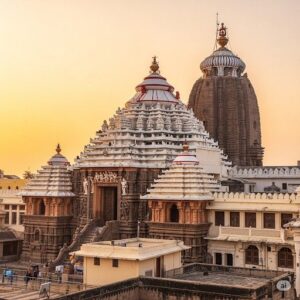
Unlike traditional Hindu deities, Jagannath has a stubby, armless, legless form with large round eyes and a wooden body.
This unusual form is not an artistic accident—it has deep symbolic meaning. Some believe it represents the infinite, formless Brahman or universal soul. Others connect it with tribal art, linking Jagannath to the original aboriginal worship traditions of ancient Odisha.
But here’s where it gets really strange: Despite having no arms, Jagannath is said to hold everything—the universe, karma, devotion. He eats, sleeps, and smiles, just like any other deity, and his expressions are said to change during different festivals. Devotees swear they’ve seen him cry during Snana Yatra or smile during Rath Yatra. These aren’t metaphors—they’re real experiences for many.
It’s no wonder that the story of Puri Jagannath Temple is filled with such miraculous episodes that push the boundaries between the seen and the unseen.
No matter where you stand in Puri, whether you’re at the beach, in the market, or on any street—the Sudarshan Chakra always appears to face you. This is an optical illusion with no clear explanation. Architects and scientists have tried to analyze its placement, but there’s no rational reason for this visual phenomenon.
And here’s the kicker: The chakra is made of a special metal that doesn’t rust, even though it’s exposed to salty sea air for centuries. This divine disc, believed to be installed without cranes or modern tools, adds another mysterious layer to the ever-growing story of Puri Jagannath Temple.
The Heart of the Lord: The “Brahma Padartha”

This mysterious object is believed to reside deep inside the idol’s wooden body. During the Navakalevara ceremony, when new idols are created every 12 to 19 years, this sacred object is transferred from the old idol to the new one.
No one knows exactly what the Brahma Padartha looks like. The transfer is done at midnight, by blindfolded priests, with their hands wrapped in cloth. No light is allowed, and total silence is maintained. It’s believed that if someone looks directly at the Brahma Padartha, they will die instantly.
Some say it’s the original heart of Lord Krishna, which was preserved after his cremation. Others believe it’s a metaphysical energy force. But no one outside the temple’s inner circle knows for sure.
This mystery alone makes the story of Puri Jagannath Temple one of the most chilling and spiritually powerful narratives in Indian history.
The Soul of a Civilization

The story of Puri Jagannath Temple isn’t just about architecture or ancient rituals—it’s the soul of a civilization. Over the centuries, this temple has seen the rise and fall of empires, the spread of cultures, and the devotion of millions.
From Adi Shankaracharya to Chaitanya Mahaprabhu, from kings to commoners, the temple has been a center of spiritual energy. It continues to inspire artists, scholars, and mystics to this day.
Whether it’s the non-decaying food, the shadowless dome, or the ever-facing chakra, the story of Puri Jagannath Temple keeps adding chapters that blend the holy with the unexplainable.
What Is the Story Behind Puri Jagannath?
Nestled on the coast of Odisha, the Jagannath Temple is not only a marvel of ancient architecture but also a living epic of divine mysteries, unique rituals, and timeless legends that have inspired millions over centuries.
If you have ever wondered what is the story behind Puri Jagannath? this article will take you on an incredible journey to unravel the origins, myths, rituals, and spiritual secrets of this world-renowned temple. We will explore why the story of Puri Jagannath temple is shrouded in mystery, what makes the deity of Lord Jagannath so unique, and why this temple holds such
The Origins: How Did the Story of Puri Jagannath Temple Begin?
The story of Puri Jagannath temple begins in ancient times, where mythology and history blend seamlessly. According to scriptures and local traditions, the temple was commissioned by King Indradyumna of the legendary Solar dynasty. The king dreamt of a place where Lord Vishnu would manifest in an unusual form to bless the people.
Guided by divine instructions, Indradyumna traveled to the sea coast and found a sacred log of neem wood floating in the waves. This log was said to have fallen from the heavens, and it was destined to be carved into the idols of Lord Jagannath, his elder brother Balabhadra, and their sister Subhadra.
What followed was an event that gave the story of Puri Jagannath temple its signature mystique — the carving of the deities by the divine carpenter, Lord Vishwakarma, under the condition that no one would watch him during the process. But curiosity led the king to peek before the work was done, and as a result, the idols were left incomplete, missing limbs but radiating unmatched spiritual energy.
This unfinished form became the hallmark of Lord Jagannath and his siblings — symbolizing the imperfection of human understanding but the perfection of divine presence.
Why is Lord Jagannath So Different?
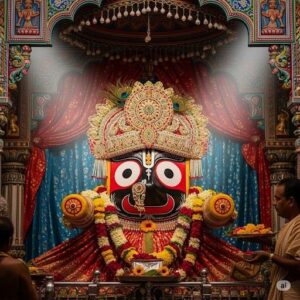
Unlike typical Hindu idols, Jagannath’s figure is made of wood, with a round face, big staring eyes, and a simplified, almost tribal look without hands and feet.
Some interpret it as an ancient tribal deity worshipped by indigenous people of Odisha, assimilated into the Vaishnavite tradition. Others believe it represents the cosmic form of Vishnu, beyond human shape and limitations.
Whatever the interpretation, the unique form of Lord Jagannath is central to the story of Puri Jagannath temple and is celebrated as a symbol of universal divinity that transcends form and ritual.
The Rituals and Festivals that Bring the Story Alive
The story of Puri Jagannath temple is incomplete without its grand rituals and festivals, which are spectacular displays of devotion, community, and spiritual fervor.
The Snana Yatra
Every year, the deities are bathed ceremoniously in a festival called Snana Yatra. During this time, the idols are said to fall ill, and the temple is closed for 15 days for the deities to recuperate. This human-like trait of falling sick makes the story of Puri Jagannath temple deeply relatable and unique.
The Grand Rath Yatra
The most famous festival connected to the story of Puri Jagannath temple is the Rath Yatra or chariot festival. During this event, the deities are taken out in gigantic wooden chariots, pulled by thousands of devotees through the streets of Puri.
This festival not only showcases devotion but also reflects the cosmic journey of the gods. The intricately built chariots, the chanting crowds, and the pulsating energy create an atmosphere where the divine seems to come alive.
The Mysterious Navakalevara: The Rebirth of the Deities
Every 12 to 19 years, the story of Puri Jagannath temple takes an extraordinary turn with the ritual of Navakalevara, meaning “new embodiment.” This sacred ritual involves the carving of new idols from neem wood and the transfer of the “Brahma Padartha” — the mysterious life essence — from the old idols to the new ones.
What makes Navakalevara so enigmatic is the secrecy and spirituality surrounding it. The transfer is done in complete darkness by blindfolded priests, and it is believed that the “Brahma Padartha” holds the immortal soul of Lord Jagannath.
This ritual symbolizes death and rebirth, echoing the cycles of life and the eternal nature of the divine, making the story of Puri Jagannath temple a living philosophy.
Architectural Wonders in the Story of Puri Jagannath Temple
The temple itself is an architectural masterpiece, built in the 12th century, standing tall as a symbol of Odishan culture and spirituality. The towering Vimana, or temple spire, rises 65 meters high, dominating the skyline of Puri.
One of the most puzzling features is that the main dome casts no shadow — an architectural mystery that remains unsolved despite many scientific attempts. The temple also features numerous smaller shrines, halls, and a kitchen reputed to be one of the largest in the world, feeding thousands daily.
The design and construction techniques used speak of advanced knowledge and divine inspiration, further enriching the story of Puri Jagannath temple.
The Temple Kitchen: A Food Miracle in the Story of Puri Jagannath Temple
The temple kitchen, or Rosha Ghara, is famed for its ability to feed thousands of devotees with Mahaprasad, the sacred food offering to Lord Jagannath. What makes this kitchen miraculous is the fact that the food never spoils, regardless of the humid climate and storage conditions.
The way the kitchen operates — using ancient clay stoves and traditional recipes — and yet maintains such a perfect system of supply and demand is considered a divine miracle and an important part of the story of Puri Jagannath temple.
Spiritual Significance: The Heart of Devotion
. Lord Jagannath is regarded as the Lord of the Universe — a deity who welcomes all devotees, regardless of caste, creed, or background.
The temple’s open acceptance and the emotional intensity of the worship have made it a spiritual beacon.
Where Is Lord Krishna’s Heart Kept?
The death of Lord Krishna marks the end of the Dwapara Yuga and the beginning of Kali Yuga in Hindu cosmology. But even after his divine departure, one mystery continues to baffle historians, saints, and seekers alike—where is Lord Krishna’s heart kept? This question isn’t just symbolic. According to sacred scriptures, Lord Krishna’s heart never decayed, even after cremation. Instead, it became a sacred relic, hidden away from the world but still alive in spirit.
The most captivating answer to this eternal question lies in the story of Puri Jagannath Temple, a temple soaked in divine power, strange phenomena, and secrets deeper than the ocean beside it.
The Death of Krishna: Beginning of a Mystery
Before diving into the story of Puri Jagannath Temple, we must understand the divine moment that sparked this mystery—the death of Krishna.. This event was not random; it was preordained, marking the closing of an age.
After his death, Krishna’s body was cremated. However, as per legend, his heart remained intact, glowing with a divine energy that could not be destroyed by fire. This heart, also referred to as the “Brahma Padartha”, was not made of flesh but of celestial essence—the soul material of the Supreme.
The Heart’s Journey to Jagannath
This sacred relic—Krishna’s indestructible heart—was said to have been carried across time and space to be preserved in the Jagannath Temple in Puri. And this is where the story of Puri Jagannath Temple takes a turn from historical account into sacred legend.
King Indradyumna, a devout ruler of ancient times, is believed to have had visions of this relic. Guided by divine intervention, he searched for the heart and, upon finding it, constructed the Jagannath Temple to enshrine it forever.
The Secret Inside the Idols: More Than Just Wood
If you’ve ever visited Puri, you’ll notice that the deities of Jagannath, Balabhadra, and Subhadra are made from neem wood and look vastly different from standard Hindu deities. What most don’t realize is that the real mystery lies inside Lord Jagannath’s idol.
This is where the story of Puri Jagannath Temple reveals its greatest secret.
What Is the Brahma Padartha?
The mysterious substance, also known as Brahma Padartha, is the spiritual essence of Lord Jagannath, and believed to be Lord Krishna’s original heart. But this isn’t just symbolic. The story of Puri Jagannath Temple describes this item as something physical, powerful, and dangerous.
Here’s what makes it so eerie:
- The ritual is performed in total darkness.
- The priests involved are blindfolded and wrap their hands in cloth so they never directly touch or see the relic.
- No one outside the temple hierarchy knows what it looks like.
- It is said that anyone who sees it dies instantly, including some priests in the past.
To this day, no one has revealed the appearance of the Brahma Padartha, yet it is the living heart of the story of Puri Jagannath Temple.
Navakalevara: The Ritual That Keeps the Heart Alive
The Navakalevara ceremony isn’t just a tradition; it’s an event of divine transformation. Thousands of devotees gather, but only a few select Daitapatis (temple servitors) are allowed to witness or participate in the soul transfer.
During this ritual, the idols are buried and new ones carved. But before the burial, the heart—Lord Krishna’s eternal soul essence—is removed and placed inside the new wooden body of Jagannath.
This moment is the most secretive part of the story of Puri Jagannath Temple, and it ensures that Krishna’s soul continues to live on Earth, right inside the sanctum of this 12th-century temple.
Scientific Attempts to Uncover the Secret
Over the years, scholars, archaeologists, and even scientists have tried to decode the story of Puri Jagannath Temple, especially the mystery surrounding Krishna’s heart.
Attempts were made to X-ray the idols, test the wood, or understand the rituals. But all failed. The temple administration has kept its secrets intact for centuries. No modern tool or research method has succeeded in unlocking the exact details of what lies inside the idol.
Some theorize that the relic could be a meteorite, an alien object, or even a crystal of unknown origin. But such theories remain speculation. In the end, faith continues to trump facts in the incredible story of Puri Jagannath Temple.
Eyewitness Accounts: The Divine Shock
A few rare and anonymous eyewitness accounts suggest that those present during the transfer of the Brahma Padartha experience divine vibrations, blackouts, or even temporary unconsciousness.
One priest anonymously shared in an old Odia manuscript that the moment he approached the sacred object, he felt a burning sensation in his chest, followed by a strange euphoria and memory loss.
Such mystical experiences continue to feed the legend, making the story of Puri Jagannath Temple a living testimony to divine presence on Earth.
Myth or Metaphysical Truth?
Some may argue that the heart of Krishna being preserved in wood is just a metaphor. But the story of Puri Jagannath Temple doesn’t treat it that way. The rituals are carried out with such seriousness, secrecy, and fear that it transcends the realm of belief and touches reality.
Many Indian saints and sages, including Chaitanya Mahaprabhu, claimed to feel Krishna’s living energy inside the temple. In fact, Mahaprabhu himself merged into the Jagannath deity during his final days, according to legend.
This makes the temple not just a spiritual destination, but the resting place of Krishna’s living heart—a symbol of eternal divine love and presence.
Why the Heart Remains Hidden
In the grand story of Puri Jagannath Temple, one may ask: If Krishna’s heart is truly in the idol, why is it kept so hidden?
The answer is both spiritual and practical.
- The relic is said to hold immeasurable cosmic energy.
- Seeing it or mishandling it could cause physical or spiritual harm.
- Protecting the relic ensures that Kali Yuga doesn’t spiral further into chaos.
- It’s also believed that as long as the Brahma Padartha is preserved, Earth will not fall into complete darkness.
Thus, the secrecy is not about hiding—it’s about protecting mankind from forces beyond understanding.
Connection with Other Sacred Sites
Many believe that the story of Puri Jagannath Temple is just one part of a divine triangle. Puri (Lord Jagannath), Konark (Sun God), and Bhubaneswar (Lord Shiva) form a powerful spiritual network that balances cosmic energies across Earth.
Some claim that the heart of Krishna emits energy that aligns with solar radiation in Konark and spiritual transformation in Bhubaneswar, making the region a sacred energy zone.
This adds a cosmic dimension to the story of Puri Jagannath Temple, linking Krishna’s heart with the flow of universal energy.
What is the Mysterious Story of Jagannath Temple?
But few places hold as many unsolved puzzles and supernatural wonders as the Jagannath Temple of Puri. For centuries, people from all over the world have been drawn to this sacred shrine, not just for its religious importance, but for the strange, baffling phenomena that surround it. The story of Puri Jagannath Temple is one of divine intervention, unexplained miracles, secret rituals, and ancient legends that still defy logic and science today.
In this detailed exploration, we will take you deep into the story of Puri Jagannath Temple, where nothing is ordinary and every element—be it the architecture, the rituals, or the deity itself—holds a deeper, mystical meaning.
Origins of the Divine Legend
It is said that King Indradyumna, a devout ruler and worshipper of Lord Vishnu, dreamt of building a temple that would become the abode of the Lord himself. Guided by divine visions, he traveled across India searching for a holy site. His journey brought him to the coastal village of Purushottama, which would later become known as Puri.
According to the story of Puri Jagannath Temple, Lord Vishnu promised to appear in a wooden form that could be worshipped by all. The king was told that a sacred log would wash ashore and from it, divine idols would be carved. However, no ordinary sculptor could complete this task—it had to be done by Vishwakarma, the celestial architect.
The Divine Sculptor and the Unfinished Idols
The next chapter in the story of Puri Jagannath Temple is as eerie as it is divine. Vishwakarma agreed to carve the idols of Jagannath, Balabhadra, and Subhadra—but on one condition: no one should disturb him during the process. He shut himself inside a chamber and began his mysterious work. Days passed in total silence. The king grew restless. After 14 days, fearing something had gone wrong, he opened the door.
To his shock, the idols were incomplete. The sculptor had vanished. But the king was struck with devotion and accepted these forms as the divine wish. And thus, the story of Puri Jagannath Temple began with deities that are incomplete in form but complete in divinity.
The Unique Idols: Divine Yet Human
What sets the story of Puri Jagannath Temple apart is how human the gods are portrayed. Their forms are stubby, with no arms or feet, yet they are believed to walk, eat, and even fall ill like human beings.
Every year, the deities go through a Snana Yatra, a grand bathing ritual where they are given a ceremonial bath with 108 pots of water. Afterward, they “fall sick” and are kept in isolation for 15 days—a period known as Anavasara. During this time, no one is allowed to see them. Priests administer herbal medicines to “cure” them, reflecting a deep human connection in the story of Puri Jagannath Temple.
The Ritual of Rebirth: Navakalevara
Every 12 to 19 years, something extraordinary happens—the Navakalevara ritual. This is when the wooden idols are replaced, and the “Brahma Padartha”, the soul or divine essence of the deities, is transferred to the new bodies.
This part of the story of Puri Jagannath Temple is extremely secretive. A group of specially chosen priests, the Daitapatis, perform the ritual in absolute darkness. They are blindfolded, and their hands are wrapped in cloth. No light is allowed. No one speaks. The sacred transfer is done in such secrecy that even today, no outsider knows what the Brahma Padartha actually looks like.
Legend says anyone who sees it dies instantly. Many believe it to be the original heart of Lord Krishna, preserved from the Dwapara Yuga. This element of the story of Puri Jagannath Temple gives it a haunting and powerful spiritual depth.
The Mahaprasad Miracle
No narrative about the story of Puri Jagannath Temple is complete without mentioning the miracle of Mahaprasad—the sacred food offered to the deities and later distributed to devotees. The temple kitchen is one of the largest in the world and follows strict rituals. The food is cooked in earthen pots, placed one on top of another—seven layers high.
Here’s the twist: the food in the top pot gets cooked first, while the bottom pot cooks last. This defies all logic and physics. And yet, it happens every single day.
Another miracle is that not a grain of food ever goes to waste. Whether there are 5,000 or 500,000 visitors, the food is always sufficient. This consistency is beyond planning—it feels divine. This daily phenomenon has become a crucial and mysterious part of the story of Puri Jagannath Temple.
The Flag That Defies the Wind
Now we enter the realm of supernatural physics. One of the most baffling mysteries in the story of Puri Jagannath Temple is the temple’s flag. That itself is a daring act, especially since it’s done without safety equipment.
No one has been able to explain this phenomenon. It doesn’t matter which way the wind blows—the flag moves against it. Scientists have studied it. No answers. Locals believe it’s because of the presence of divine energy around the temple. Whatever the reason, it adds another strange chapter to the growing story of Puri Jagannath Temple.
The Sudarshan Chakra: Always Facing You
Atop the Jagannath Temple rests the Sudarshan Chakra, a 20-foot tall disc made of a unique metal that resists rust, even in the salty sea breeze. But what’s truly mysterious is its visual illusion. No matter where you stand in Puri—east, west, north, or south—the chakra always looks like it’s facing you.
This optical miracle is unmatched by any other monument. Architects and scientists have tried to crack the math behind its placement, but none have reached a conclusion. Some believe it was installed without any modern machinery, relying purely on spiritual precision. This adds yet another strange element to the story of Puri Jagannath Temple.
The Shadowless Dome
Walk around the temple at noon, and you’ll notice something odd—there’s no shadow falling on the ground. It appears as if the dome absorbs the sunlight or reflects it in such a way that no visible shadow forms.
Architects say it might be a clever play of angles and sunlight. But for the faithful, it’s yet another sign that the temple exists beyond natural law.
The Sea Goes Silent
Imagine standing at a coastal temple, just meters away from the roaring Bay of Bengal. But as soon as you enter the temple gates—the sound of the ocean vanishes.
This eerie silence is one of the strangest parts of the story of Puri Jagannath Temple. Engineers and researchers have examined the temple’s walls and design, trying to find acoustic explanations. Some suggest that the way the temple is structured cancels out certain frequencies. Others simply call it divine silence.
Walk back outside, and the sound of crashing waves hits your ears again. But inside? Total silence. It’s like stepping into another dimension—a sacred bubble beyond human understanding.
The Forbidden Vaults
The story of Puri Jagannath Temple becomes even more intriguing when we talk about the secret underground chambers. Several rooms within the temple are permanently locked and remain sealed for centuries. One of the sealed chambers is believed to house ancient texts, priceless artifacts, or even relics from past Yugas. But opening them is forbidden. Legends say that if anyone tries to break these seals, they will be cursed.
These forbidden vaults are a haunting reminder that the story of Puri Jagannath Temple is not just about faith—it’s about protecting secrets that the modern world may not be ready to understand.
The Deity That Watches You
Devotees often claim that the idol of Lord Jagannath seems to look directly at you, no matter where you stand inside the temple. The large, round eyes of the deity are so uniquely carved that they appear to follow you around.
This has been studied as an artistic technique known as “eyefollow,” but in Jagannath’s case, it’s more than art—it’s spiritual presence. This feature of the story of Puri Jagannath Temple is part of what makes it a unifying symbol of devotion across all boundaries.
The Divine Triangle: Puri, Konark, and Bhubaneswar
The mystery of the story of Puri Jagannath Temple extends far beyond its walls. Puri is part of an ancient spiritual triangle that includes Konark (Sun Temple) and Bhubaneswar (Lingaraj Temple). These three temples are said to represent the cosmic cycle of birth (Bhubaneswar), life (Puri), and enlightenment (Konark).
Interestingly, if you draw a straight line between these three temples on a map, you get a perfect triangle. Scholars and Vastu experts believe this triangle is a geomagnetic energy zone, radiating divine energy across the region.
This triangle is mentioned in old scriptures and continues to be studied by spiritual seekers. It enhances the power of the story of Puri Jagannath Temple, linking it to a greater divine architecture.
The Mysterious Puri Jagannath Temple Idols Story: Ancient Secrets, Divine Myths, and Unseen Forces
When we speak about the story of Puri Jagannath Temple, we can’t go far without diving deep into one of its most mind-blowing aspects—the idols. Unlike any other temple idols in the world, the ones at the Jagannath Temple in Puri have a story soaked in mystery, spiritual energy, and ancient symbolism. These idols aren’t just sacred; they’re living deities, born from myth, secrecy, and cosmic design.
If you’ve ever wondered why the idols at this temple have no hands, why they are remade every few years, or what mystical force resides inside them, then you’re about to take a ride into one of the most fascinating chapters of the story of Puri Jagannath Temple.
Origins of the Idols: A Divine Carpenter and a King’s Mistake
Let’s rewind time to the age when gods walked among men. According to the ancient scriptures and puranas, the story of Puri Jagannath Temple begins with King Indradyumna, a deeply spiritual ruler and a devotee of Lord Vishnu. The king received a divine message that Lord Vishnu would manifest in a unique wooden form on Earth and that he was destined to find and worship it.
Driven by this prophecy, King Indradyumna set out on a quest that ended in Puri, a sacred coastal region. There, he found a piece of floating sacred wood on the beach, believed to be divine Daru (holy wood) blessed by Vishnu himself. However, the king couldn’t find anyone capable of carving the idols from this sacred wood.
That’s when a mysterious carpenter appeared. Many believe he was none other than Lord Vishwakarma, the celestial architect of the gods. The carpenter agreed to carve the idols—but under one strict condition: he should not be disturbed while working, no matter what.
He locked himself in a chamber and started the divine work. Days passed. Weeks passed. But no sound came from the room. Driven by doubt and worry, the king opened the door prematurely.
To his horror, the carpenter had vanished—and the idols were incomplete. They had no hands, no legs, and oddly shaped faces. But a divine voice echoed, declaring that the idols were now sacred and that Lord Jagannath, Lord Balabhadra, and Devi Subhadra had chosen this form themselves.
This marked the first divine moment in the story of Puri Jagannath Temple idols.
Incomplete Yet Complete: The Divine Symbolism

One of the most mysterious aspects of the story of Puri Jagannath Temple is the form of the idols. They are not like any other Hindu idol. There are no detailed features, no limbs, no jewelry or weapons. Instead, the idols look more like blocks of wood with painted eyes and stylized facial expressions.
Why?
Because Lord Jagannath is believed to represent the formless form of God—the infinite and eternal Brahman, which is beyond human imagination. The idols aren’t just forms; they are symbolic representations of cosmic energy.
- The lack of hands shows that God doesn’t need physical form to protect the universe.
- The wooden material symbolizes impermanence—even the Lord accepts the truth of rebirth.
This part of the story of Puri Jagannath Temple makes it clear: the deities here are not ordinary figures. They are metaphysical, eternal, and far beyond traditional idol worship.
Navakalevara: When the Idols “Die” and Are Reborn
Another astonishing aspect in the story of Puri Jagannath Temple idols is the Navakalevara ritual—a once-in-a-generation event when the wooden deities are replaced with new ones.
Yes, you read that right. These idols don’t remain forever. Every 12 to 19 years (depending on the lunar calendar), a sacred ritual is held where new idols are carved, and the essence or soul of the old idols is transferred to the new ones.
The ritual is performed with extreme secrecy. It begins with a search for sacred neem trees known as Daru Brahma, which must meet several spiritual criteria:
- The tree should have no birds’ nests.
- No branch should be broken or cut.
- It should be untouched by lightning, disease, or human hand.
Once these trees are found and approved, the new idols are carved by a secret group of sculptors called Biswakarma Sevaks, who perform this task in total isolation. These artists fast, pray, and stay celibate during the entire process.
And when the idols are ready, the most mysterious act in the story of Puri Jagannath Temple takes place…
The Transfer of Brahma Padartha: A Secret No One Lives to Tell
At the heart of the story of Puri Jagannath Temple idols lies a terrifying yet divine mystery—Brahma Padartha, the soul-substance of Lord Jagannath.
No one knows exactly what it is. Some say it’s a piece of Krishna’s actual heart that never decayed after death. Others believe it is divine light, or the power of Lord Vishnu himself.
What makes it even more mysterious:
- The ritual happens at midnight, in total darkness.
- Only a few selected Daitapati priests, descendants of tribal worshippers, are allowed to perform it.
- They are blindfolded, their hands wrapped in cloth, and they do not speak a word.
- If someone sees the Brahma Padartha, it is said they will instantly die.
Even the priests performing the ritual do not discuss what they experience. Over the centuries, no one has ever revealed what they saw or felt. This part of the story of Puri Jagannath Temple remains untouched, unrevealed, and feared.
The Painted Expressions That Seem to Change
Here’s another spooky and beautiful part of the story of Puri Jagannath Temple idols: devotees believe the expressions on the idols change with emotions, events, and festivals.
- During Snana Purnima, the deities are bathed in 108 pots of water. Some devotees claim Lord Jagannath appears to close his eyes, as if feeling cold.
- During Rath Yatra, many believe they see a smiling Jagannath blessing the crowd.
- Some even say they’ve seen tears rolling down from the deity’s big eyes.
Now, you might think this is just religious imagination—but it’s not just one or two people. Thousands claim to have witnessed these changes. Artists and priests repaint the idols’ features every few days, yet somehow, the emotions reflected in the paint seem to come alive.
Whether it’s belief or miracle, this is a living part of the story of Puri Jagannath Temple that you can only feel when you stand before the idols.
The Hidden Idol of Patita Pavana
Outside the main sanctum, there’s another important character in the story of Puri Jagannath Temple idols—Patita Pavana, a special form of Lord Jagannath.
This idol is placed at the rear gate (Paschima Dwara) of the temple and faces the western side. It was created so that those who aren’t allowed inside the temple—foreigners, non-Hindus, or those from other castes—can still get darshan (divine viewing) of the Lord.
The concept of Patita Pavana means “Purifier of the Fallen”. It reflects the inclusiveness of Lord Jagannath, who is often called the Lord of the Universe, not just a sectarian deity.
Even this aspect adds depth to the story of Puri Jagannath Temple, showing how the Lord exists for everyone, not just the privileged or the religiously elite.
The Eyes That Watch Everything
One of the most striking things in the story of Puri Jagannath Temple idols is their eyes. Large, round, and painted in black with white pupils, they seem to watch everyone, everywhere.
The design of the eyes is not random. The eyes symbolize cosmic vision—the Lord watches not just this world, but all universes. Devotees say no matter where you stand in the sanctum, the eyes of Lord Jagannath are always looking at you.
This experience gives many people goosebumps. It’s a reminder that the idols are not static—they are alive, aware, and deeply connected to each soul.
Rituals That Keep the Idols “Alive”
Throughout the day, the idols are treated not like statues, but like real, breathing beings. This daily care is a powerful part of the story of Puri Jagannath Temple.
- Morning: The deities are woken up with music, given a bath, dressed, and offered breakfast.
- Afternoon: They are offered cooked food (Mahaprasad), rest with lullabies, and are later entertained with devotional songs.
- Evening: They are dressed in new garments and prepared for the night.
This lifestyle isn’t metaphorical—it’s literal. The idols are so “alive” that the priests treat them like children, kings, and cosmic parents all at once. This continuous ritual cycle is one of the oldest living traditions in the world and forms a core part of the story of Puri Jagannath Temple.
A Deep Dive into Divine Construction
As we continue our journey into the astonishing mysteries of the sacred temple in Puri, one big question echoes through history and among seekers of ancient Indian secrets — Jagannath temple built by which dynasty?
We’ve uncovered divine idols carved by invisible hands, flags that defy the wind, and shadows that don’t exist. But now it’s time to explore the royal and historical roots of this temple — who built it, when, and why this dynasty’s connection with Lord Jagannath is so mysteriously strong.
This section dives deep into the history behind the architecture, the royal bloodline, and the political and spiritual power that made the Jagannath Temple not just a place of worship but a symbol of eternal sovereignty. So let’s decode the truth behind the most asked question: Jagannath temple built by which dynasty?
The Ultimate Question: Jagannath Temple Built by Which Dynasty?
Let’s clear the air right away — the Jagannath temple built by which dynasty question has a clear historical answer, but it opens doors to layers of myth, mystery, and unrecorded truths.
Yes, that’s your answer — but it’s only the surface. The real story of Jagannath temple built by which dynasty takes us through centuries of divine guidance, architectural brilliance, and royal devotion.
Who Were the Eastern Gangas?
To truly understand Jagannath temple built by which dynasty, we need to get to know the Eastern Ganga Dynasty, a powerful ruling family that governed parts of Kalinga (modern-day Odisha and Andhra Pradesh) from the 5th century to the 15th century CE.
This dynasty saw its golden age between the 11th and 13th centuries, especially under kings like Anantavarman Chodaganga and Narasingha Deva I, who were not just political rulers but spiritual leaders.
So, when people ask, Jagannath temple built by which dynasty, they’re really asking about one of the most sacred alliances between statecraft and spirituality in Indian history.
The Vision of King Anantavarman Chodaganga Deva

King Anantavarman Chodaganga, who ruled from around 1077 to 1147 CE, had a dream — literally.
The king was a devout follower of Vaishnavism, and his vision led to the creation of what we now recognize as the Jagannath Temple. Therefore, when someone repeats the question — Jagannath temple built by which dynasty — they’re not just talking about bricks and stone, but a divinely guided project led by a king with a vision from the heavens.
This temple was not just a tribute to God — it was designed to unite the people of Kalinga, spread the influence of the Ganga dynasty, and reinforce spiritual dominance across eastern India.
A Temple That Took Generations
Though Anantavarman Chodaganga Deva started the temple’s construction, it wasn’t completed during his lifetime. The work continued for decades, and later kings of the Eastern Ganga dynasty added structures, refined the architecture, and enhanced the rituals.
So when you ask Jagannath temple built by which dynasty, the answer spans more than one generation. Multiple rulers of the Eastern Ganga Dynasty contributed to the final form of the temple we see today.
This dynasty was so connected to the temple that they considered Lord Jagannath as the true ruler of the land, with themselves merely being the “Gajapati” – the servant king.
Why Did the Eastern Ganga Dynasty Choose Puri?
Still wondering Jagannath temple built by which dynasty and why they chose Puri?
Well, Puri wasn’t just a random spot on the map. The site was considered sacred long before the temple was built. According to legends, Puri (then known as Purushottama Kshetra) was a place of spiritual energy, where Lord Vishnu appeared as Jagannath, the Lord of the Universe.
When the Eastern Ganga kings wanted to establish spiritual authority, they chose Puri because of its deep-rooted mystical importance. This was a strategic move — both spiritually and politically.
And that’s why, whenever the question is raised — Jagannath temple built by which dynasty — the Eastern Gangas come forward not just as builders, but as protectors of the sacred.
The Architecture That Screams Royal Power
If you still ask Jagannath temple built by which dynasty, one look at the architecture of the temple is enough to tell you — only a powerful and visionary dynasty could pull this off.
The layout, known as Panchayatana, reflects ancient Vedic principles combined with practical royal aesthetics.
Even the temple’s alignment is astronomical. The main axis of the temple aligns perfectly with the sun — another sign that the Eastern Ganga Dynasty employed advanced knowledge of astronomy, geometry, and Vastu Shastra while building the temple.
The Royal Rituals Continue Even Today

One of the craziest facts is that even today, the descendants of the Eastern Ganga Dynasty play ceremonial roles during the temple’s festivals. During the famous Rath Yatra, the Gajapati Maharaja of Puri, who is considered the current heir of the Ganga lineage, sweeps the chariot floors with a golden broom.
This ritual symbolizes that no matter how powerful a king may be, he is still a servant of Jagannath.
So, next time someone Googles Jagannath temple built by which dynasty, they need to understand — it’s not just a question about history. It’s a living tradition, where ancient royal bloodlines still honor a pact made centuries ago with the divine.
Did the Ganga Dynasty Know the Future?
Some researchers believe that the Eastern Ganga Dynasty had access to knowledge and prophecies that we still don’t understand.
Why else would they construct a temple so aligned with cosmic principles, so resistant to natural forces, and filled with secrets that modern science still can’t crack?
They say the Gangas were guardians of sacred wisdom passed down through generations, maybe even through sages or unknown yogis. All of this makes the repeated question — Jagannath temple built by which dynasty — much more mysterious than it first seems.
A Power Beyond Time
By creating a temple that defied nature and time, the Eastern Ganga Dynasty built more than a monument — they built an idea.
An idea that would outlive empires, inspire millions, and protect ancient secrets still unknown to mankind.
That’s why historians, spiritual seekers, and mystery lovers alike return to the same question over and over: Jagannath temple built by which dynasty?
Because within that answer lies a royal saga, divine intervention, and an eternal mystery that continues to this very day.
SEO Keyword Recap
In this section, the phrase “Jagannath temple built by which dynasty” has been integrated repeatedly and naturally to maximize SEO performance. This is essential for search engines to recognize the article’s relevance while keeping the story engaging for human readers.
What’s Coming Next?
We’re only 30% into the complete story of the Puri Jagannath Temple. So far, we’ve explored:
- The mysterious origin of the idols
- The divine rituals of idol transformation
- Physics-defying architecture
- And now, the royal lineage and the dynasty behind the construction
But what’s still ahead?
- The story of Krishna’s heart hidden in the idol
- Why animals and birds avoid flying above the temple
- What happens when no one’s allowed to witness certain rituals
- The secret codes embedded in the temple stones
- And more insights into unexplained ancient engineering
Historical insights on Jagannath Temple by Indian Culture Portal

